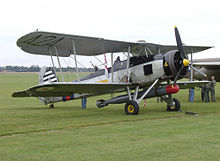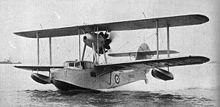List of Fleet Air Arm aircraft in World War II
This list deals specifically with aircraft of the Royal Navy's Fleet Air Arm (FAA) during World War II.
The FAA operated aircraft from Royal Navy ships, mainly aircraft carriers but also including capital ships and cruisers, as well as from land bases defending ports and attacking enemy shipping.
Carrier aircraft of World War II
[edit]Fighters
[edit]- Gloster Sea Gladiator
- Carrier-borne version of the Gladiator fitted with an arrestor hook. One of the two FAA fighters of World War II in service at the beginning alongside the Blackburn Skua.[1][2]
- Blackburn Skua
- The Skua was a fighter and a dive bomber; one of two fighter aircraft in the FAA at the onset of war, alongside the Gloster Sea Gladiator. Armed with four fixed forward-firing machine-guns in the wings and a single flexibly-mounted Vickers K machine gun in the rear cockpit, the Skua carried a large bomb launched from a swivelling crutch under the centre fuselage.[3][4]
- Blackburn Roc
- The Roc was the turret-armed escort-fighter derived from the Skua, fitted with a four-gun hydraulically-operated turret aft of the cockpit, similar to the Boulton Paul Defiant. The Roc was not procured in large numbers, due to low speed.[5][6]
- Fairey Fulmar
- The Fulmar fighter/reconnaissance aircraft was introduced into service in May 1940 and was the first FAA fighter to have eight machine-guns and also had carried a Navigator/Observer/Gunner to assist the pilot with navigation, reconnaissance and defence.[7][8]
- Hawker Sea Hurricane
- Carrier-borne and catapult-ship variants of the Hurricane introduced to service in 1941. All Sea Hurricanes, apart from the IA, were carrier-capable, being fitted with arrestor hooks.[9][10]
- Grumman Martlet (later Wildcat)
- The Martlet was a carrier fighter, armed with four 0.5 inch M2 Browning heavy machine guns, in widespread use from September 1941. The Martlet was the British name for Grumman G-36A and G-36B aircraft in British service. Later in the war new acquisitions (FM-1 and FM-2) used the US Wildcat name.[11][12]
- Supermarine Spitfire
- The Spitfire was used by land-based squadrons.
- Supermarine Seafire
- A navalised version of the Spitfire which entered service in November 1942.[13][page needed][14][page needed]
- Vought F4U Corsair
- The Corsair was used by the FAA from November 1943, with modifications to suit them to service on British carriers.[15][page needed][16]
- Grumman Hellcat
- Hellcat was a more developed aircraft than Wildcat, armed with six 0.5 inch M2 Browning heavy machine guns. It entered widespread service with FAA in early 1944 under the US Hellcat name. Was used in both Europe and the Mediterranean.[17][18]
- Fairey Firefly
- The Firefly was the last FAA carrier-fighter put into service in World War II, in July 1944, as a reconnaissance and strike fighter. [19][20]
-
Gloster Sea Gladiator
-
Blackburn Skua
-
Blackburn Roc
-
Fairey Fulmar
-
Hawker Sea Hurricane IB.
-
FAA Grumman Wildcat/Martlet
-
Supermarine Seafire
-
FAA Vought Corsair
-
Hellcats of 1840 Naval Air Squadron FAA.
-
Fairey Firefly FR.IV 1944
Torpedo bombers
[edit]



The Fairey Swordfish was the FAA's Torpedo bomber at the start of the war and probably the FAA’s most famous aircraft. It also was designed for reconnaissance/spotting and later in the war it was replaced in the frontline torpedo role and given anti-submarine duties from escort carriers.[21][22]
The Fairey Albacore was intended as a replacement for the Swordfish fulfilling the same roles with an improved engine and enclosed cabin. Went into service in 1940-1943 but was replaced by the Barracuda before the end of the war.[23]
Fairey Barracuda An all metal monoplane torpedo-bomber/dive bomber, the Barracude was the last British torpedo bomber to enter service during the war, serving from January 1943.
This aircraft came into service by the FAA in November 1943. Was originally called Tarpon but was changed to Avenger when the FAA changed to using the US names.[24][25]
Dive bombers
[edit]

All FAA torpedo bombers except the Grumman Avenger could also act as dive bombers
Combined fighter and dive bomber -the Skua could carry a single 250lb or 500 lb. bomb under the fuselage and four 40lb bombs or eight 20lb Cooper bombs under the wings.
The British took over French order for 50 Vought Vindicators after the Battle of France. Modified for British requirements, they were given the service name "Chesapeake". After brief service with 811 Naval Air Squadron in 1941 they were withdrawn from frontline and used for training.[26][27]
Reconnaissance
[edit]Reconnaissance came from planes that had been designed to undertake this role as well as an offensive role such as a fighter or bomber:
- Fairey Swordfish
- When carried, the observer was the third crewmember in addition to the pilot and "Telegraphist/Air gunner"
- Fairey Albacore
- The Albacore was designed as a torpedo/bomber/reconnaissance aircraft. For reconnaissance operations, a third crewmember was carried.
- Fairey Fulmar
- Introduced in 1940.
- Fairey Firefly
- The successor to the Fairey Fulmar entering service in 1944 initially for armed reconnaissance flights and anti-shipping strikes. The observer was seated in the rear of the fuselage.
Anti-submarine
[edit]- Fairey Swordfish
- The Swordfish in later life served as anti-submarine aircraft operating off escort carriers in convoys. To fulfill this role the Swordfish Mark II was fitted with ASV Mark II radar, the first instance of a carrier aircraft equipped with air-to-surface-vessel (ASV) radar, and RP-3 rockets. The Swordfish Kk III received the more advanced centimetric ASV Mk XI radar. This was used to destroy German midget submarine.
Other
[edit]Training after withdrawal as carrier fighter.
Non-carrier shipborne aircraft
[edit]Fighters
[edit]
The Sea Hurricane mk IA was a catapult only aircraft that was carried and launched from CAM ships. These ships only had the facilities to launch the aircraft so that if no land bases were available nearby the pilot was forced to ditch the aircraft in the sea when fuel ran out.
Reconnaissance & ship artillery spotters
[edit]
The Fairey Swordfish was deployed from normal Royal Navy ships with floats through an aircraft catapult on board the ship in order to do recon or act as an artillery spotter for the ship. Artillery spotting involved the Swordfish tracking the fall of shot from its ship and relaying back where it landed to help its ship make adjustments to their guns aim to be more accurate.

The Supermarine Walrus was a seaplane designed to be operated off battleships and cruiser for reconnaissance and as a spotter for the main armament. There were only two occasions on which it was used as a spotter but it was used for reconnaissance and air sea rescue throughout the war. With improvements in radar it was removed from some of the capital ships as it was rendered obsolete in its other role in patrolling for axis subs with ASV radar[28][29]
Land-based aircraft
[edit]
Torpedo bombers
[edit]The Beaufort was derived from a medium bomber and was used by the Fleet Air Arm from 1940 until the end of the war. The Beauforts operated could use both torpedoes and bombs and lay naval mines.[30][31]

The Bristol Beaufighter was an interim heavy fighter based on the Bristol Beaufort. It was used for attacks on Axis shipping by FAA and RAF Coastal Command. The main variant used by the FAA was the Beaufighter Mk X as used by 772 Naval Air Squadron and 728 Naval Air Squadron. In addition to the four 20mm Hispano Mk.II autocannons they carried, they were armed with either eight RP-3 rockets or a single torpedo. They were equipped with ASV radar.[32][33]
Other
[edit]- Armstrong Whitworth Whitley
- Small number used for training in Merlin engine management[34]
See also
[edit]Notes
[edit]- ^ Barber, Mark (2008). The British Fleet Air Arm in World War II. Oxford, UK: Osprey Publishing. p. 6. ISBN 978-1-84603-283-7.
- ^ Matricardi, Paolo . Aerei Militari: Caccia e Ricognitori (in Italian). Milan: Mondadori Electa, 2006.
- ^ Smith, Peter C Skua! the Royal Navy's Dive-Bomber. Barnsley, South Yorkshire, UK: Pen and Sword, 2006. ISBN 1-84415-455-6.
- ^ Brown 1980, p. 29–40.
- ^ Brew, Alec. The Turret Fighters: Defiant and Roc. Ramsbury, Marlborough, Wiltshire, UK: Crowood Press, 2002. ISBN 1-86126-497-6.
- ^ Thetford 1978.
- ^ Brown 1980, p. 69–78.
- ^ Brown, David. Fairey Fulmar Mks I & II, Aircraft Number 254. London: Profile Publications, 1973. No ISBN.
- ^ Brown 1980, p. 114.
- ^ Thetford 1994, p. 228.
- ^ Jones Ben, (ed). The Fleet Air Arm in the Second World War volume II, 1942–1943, the Fleet Air Arm in Transition: the Mediterranean, Battle of the Atlantic and the Indian Ocean. London: Routledge, 2018. ISBN 978-0-8153-5507-6.
- ^ March, Daniel J. (ed). British Warplanes of World War II. London: Aerospace Publishing. 1998. ISBN 1-874023-92-1.[page needed]
- ^ Brown, David (1989). The Seafire: The Spitfire That Went to Sea. London: Greenhill Books. ISBN 1-85367-039-1.
- ^ Sturtivant, Ray and; Burrow, Mick (1995). Fleet Air Arm Aircraft 1939 to 1945. Tonbridge, Kent, UK: Air-Britain (Historians) Ltd. ISBN 0-85130-232-7.
- ^ March, Daniel J. "British Warplanes of World War II". Westport, CT: AIRtime Publishing Inc., 1998. ISBN 1-880588-28-5.
- ^ Styling, Mark. Corsair Aces of World War 2 (Osprey Aircraft of the Aces No 8). London: Osprey Publishing, 1995. ISBN 1-85532-530-6.[page needed]
- ^ Thruelsen, Richard (1976). The Grumman Story. Westport, Connecticut: Praeger Publishers, ISBN 0-275-54260-2. p. 181.
- ^ Tillman, Barrett (1996). Hellcat Aces of World War 2. London: Osprey Aerospace, ISBN 1-85532-596-9. p. 78.
- ^ Brown 1980, p. 145–157.
- ^ Harrison, William A. Fairey Firefly – The Operational Record. Shrewsbury, UK: Airlife, 1992. ISBN 1-85310-196-6.
- ^ Brown 1980, p. 7–20.
- ^ Kilbracken, Lord. Bring Back My Stringbag: A Swordfish Pilot at War. London: Pan Books Ltd, 1980. ISBN 0-330-26172-X.
- ^ Harrison, W.A. (2002). Fairey Swordfish and Albacore. Marlborough: Crowood. pp. 77–80. ISBN 1-86126-512-3.
- ^ Tillman, Barrett (1979). Avenger at War. London: Ian Allan. ISBN 0-7110-0957-0.
- ^ Tillman, Barrett (1999). TBF/TBM Avenger Units of World War 2. Combat Aircraft 16. Botley, UK: Osprey Publishing. ISBN 1-85532-902-6.
- ^ Green, William and Gordon Swanborough. "The Annals of Sugar Baker Two Uncle". Air Enthusiast, Eight, October 1978–January 1979. Bromley, UK:Fine Scroll. pp. 1–8, 74–79. p. 8.
- ^ Thetford 1978, p. 340.
- ^ Green, William (1972) [1962]. War Planes of the Second World War. Vol. Five: Flying Boats (5th Impr ed.). London: Macdonald & Co. ISBN 0-356-01449-5.
- ^ London, Peter. British Flying Boats. Stoud, UK: Sutton., 2003. ISBN 0-7509-2695-3.
- ^ Buttler, Tony. Bristol Beaufort (Warpaint Series No. 50). Luton, Warpaint Books Ltd., 2000. OCLC 64949059.
- ^ Barnes, C.H. Bristol Aircraft Since 1910. London: Putnam Aeronautical, 1988 (3rd revised edition). ISBN 0-85177-823-2.
- ^ Bridgeman, Leonard, ed. "The Bristol 156 Beaufighter." Jane's Fighting Aircraft of World War II. London: Studio, 1946. ISBN 1-85170-493-0. pp. 110–111.
- ^ Moyes, Philip J.R (1966). The Bristol Beaufighter I & II. Aircraft in Profile Number 137. Leatherhead: Profile Publications. p. 16.
- ^ Crosby, F. (2007). The World Encyclopedia of Bombers. London: Anness. pp. 48–49. ISBN 978-1-84477-511-8.
References
[edit]- Thetford, Owen (1994), British Naval Aircraft Since 1912, London: Putnam Aeronautical Books, ISBN 0-85177-861-5
- Thetford, Owen (1978), British Naval Aircraft Since 1912 (4th ed.), London: Putnam Aeronautical Books, ISBN 0-370-30021-1
- Brown, Eric (1980). Green, William; Swanborough, Gordon (eds.). Wings of the Navy, Flying Allied Carrier Aircraft of World War Two. London: Jane's Publishing Company. ISBN 0-7106-0002-X.












